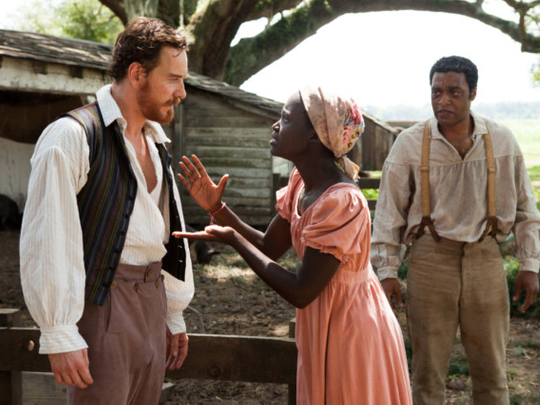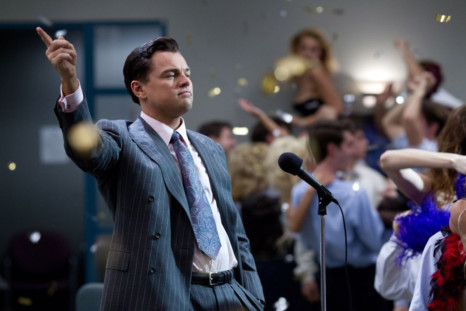
To historian Brenda Stevenson, a scholar on American slavery, 12 Years a Slave is a masterful cinematic work that achieves more than any other film on slavery, so worthy that she plans to screen it in classes at her university, UCLA.
It’s the kind of validation 12 Years a Slave has been earning from experts, critics, audiences and the film industry for six months now. Even so, the acclaimed drama may falter in the final test, losing out on the most coveted of movie prizes, the Academy Award for best picture.
The film from British director Steve McQueen appears to be the frontrunner for film’s highest honour at Sunday’s ceremony but has at least three factors conspiring against it: another high-quality, groundbreaking movie called Gravity, the tricky maths of Oscar voting and the film’s own brutal depiction of American slavery.
“I think it is a hard film to watch,” said Stevenson. “One of the things I think Steve McQueen does extremely well is capture the violence of the institution.”
That unflinching portrayal of a real American story, that of the free black man Solomon Northup who is tricked and sold into slavery, may win on the gravitas scale. But sometimes the 6,000-plus voting members of the Academy of Motion Picture Arts and Sciences just want to reward enjoyable entertainment and Gravity gives that in spades.
If this year’s nine best picture nominees add up to the strongest year for film in recent memory, they also have injected a good dose of uncertainty into Hollywood’s biggest night. Voters had a good and varied lot from which to choose, with big successes such as American Hustle and The Wolf of Wall Street, and smaller films Nebraska and Philomena.
“In the 12 to 13 years that I have been doing this stuff seriously, I can’t remember a best picture race in which there was less certainty than there is this year,” said Scott Feinberg, awards analyst at The Hollywood Reporter.
Over at the other trade publication, Variety, awards editor Tim Gray said that “more than ever, I’m totally flummoxed.” “I think best picture is between 12 Years a Slave and Gravity but I wouldn’t bet money on that,” Gray said.
In a telling sign of the tight battle, the two films had an exact tie in one of the most reliable predictors of the Oscar best picture, the Producers Guild Award.
The heightened drama around the big prize could give viewers an extra reason to tune in to the live ABC telecast of the glamorous event, hosted this year by comedian Ellen DeGeneres.
The cliffhanger category also stands in contrast to more predictable outcomes in the top acting races. Cate Blanchett should win best actress for Blue Jasmine, while Matthew McConaughey is favoured for best actor for Dallas Buyers Club and co-star Jared Leto has a lock on best supporting actor.
The best supporting actress category could see favourite Lupita Nyong’o, the slave Patsey in 12 Years a Slave, upset by Jennifer Lawrence’s loopy wife in 1970s caper American Hustle. For best animated film, the tale of Nordic princesses Frozen is expected to give the Disney Animation Studios its first Oscar in that category since it was added in 2002.
Meaningful
American Hustle and Gravity lead nominations with ten nods a piece, followed by 12 Years a Slave with nine. But if the best picture award were decided at the box office, Gravity from Warner Bros and Mexican director Alfonso Guaron would be the winner.
The outer-space thriller starring Sandra Bullock, for which Cuaron pushed the technical and visual effects boundaries, has brought in $270 million (Dh991 million) in North America and $703 million worldwide. That’s nearly as much as the $780 million earned collectively by the nine best picture nominees in the US and Canada. For his feats, Cuaron is favoured to win best director.
12 Years a Slave, in comparison, has pulled in $49 million at the domestic box office, a respectable figure for a hard-to-watch picture that features bloody whippings, lynchings and evil slave masters.
Even the studio feared members of the Academy might skip it, compelling Fox Searchlight Pictures to goad them into seeing the film with ads during the February 12-25 voting period showing slaves embraced with the tagline “It’s time.” Some Oscar watchers said the ambiguous phrase could also be seen as shaming voters.
The voting system for best picture also complicates the fortunes of the slave drama. It is a so-called preferential ballot in which members rank their top films rather than vote for just one and the consensus can emerge from films that are many people’s second or third choices.
But if history is a lesson, the Academy voters should go for the more serious subject matter.
“They generally are not looking to just reward the most fun movie, they are looking to reward the movie that has something meaningful to say,” said Feinberg.
“And if that is the case this year, the winner would clearly be 12 Years a Slave. The Academy would also make its own history with that choice: 12 Years a Slave would be the first best picture from a black director in 86 years of awards.













